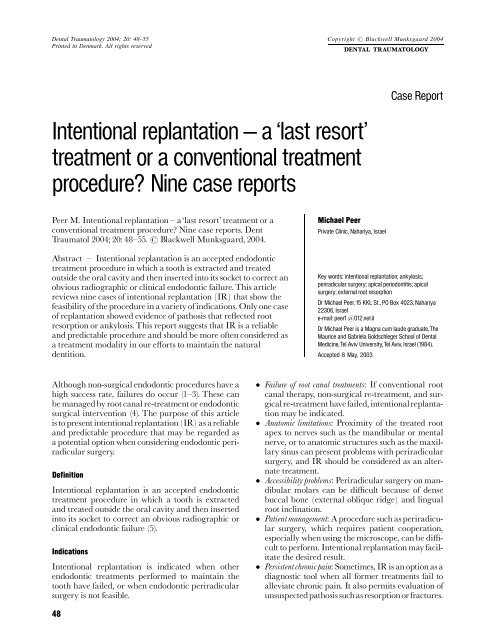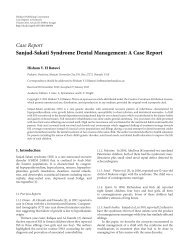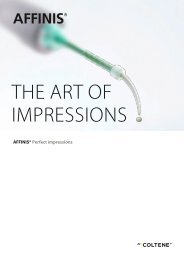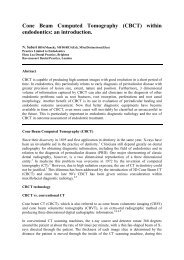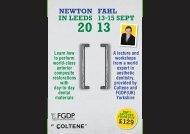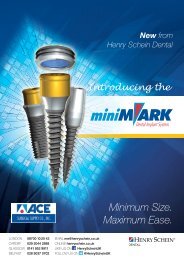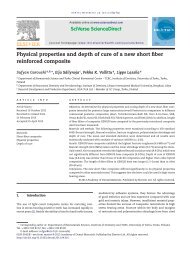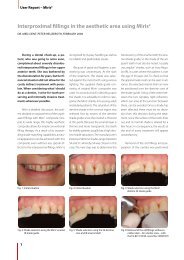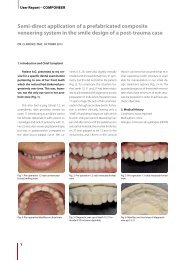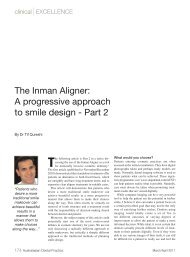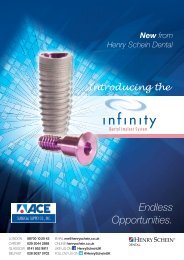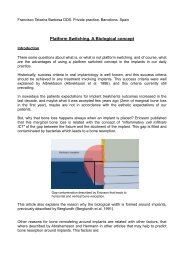Intentional replantation ^ a `last resort' treatment or a ...
Intentional replantation ^ a `last resort' treatment or a ...
Intentional replantation ^ a `last resort' treatment or a ...
You also want an ePaper? Increase the reach of your titles
YUMPU automatically turns print PDFs into web optimized ePapers that Google loves.
Dental Traumatology 2004; 20: 48±55<br />
Printedin Denmark. All rights reserved<br />
Copyright # Blackwell Munksgaard2004<br />
DENTAL TRAUMATOLOGY<br />
<strong>Intentional</strong> <strong>replantation</strong> ^ a <strong>`last</strong> <strong>res<strong>or</strong>t'</strong><br />
<strong>treatment</strong> <strong>or</strong> a conventional <strong>treatment</strong><br />
procedure? Nine case rep<strong>or</strong>ts<br />
Case Rep<strong>or</strong>t<br />
Peer M. <strong>Intentional</strong> <strong>replantation</strong> ^ a<strong>`last</strong> <strong>res<strong>or</strong>t'</strong><strong>treatment</strong> <strong>or</strong> a<br />
conventional <strong>treatment</strong> procedure? Nine case rep<strong>or</strong>ts. Dent<br />
Traumatol 2004; 20: 48^55. # Blackwell Munksgaard, 2004.<br />
Abstract ^ <strong>Intentional</strong> <strong>replantation</strong> is an accepted endodontic<br />
<strong>treatment</strong> procedure in which a tooth is extracted and treated<br />
outside the <strong>or</strong>al cavity and then inserted into its socket to c<strong>or</strong>rect an<br />
obvious radiographic <strong>or</strong> clinical endodontic failure.This article<br />
reviews nine cases of intentional <strong>replantation</strong> (IR) that show the<br />
feasibility of the procedure in avariety of indications. Only one case<br />
of <strong>replantation</strong> showed evidence of pathosis that re£ected root<br />
res<strong>or</strong>ption <strong>or</strong> ankylosis.This rep<strong>or</strong>t suggests that IR is a reliable<br />
and predictable procedure and should be m<strong>or</strong>e often considered as<br />
a <strong>treatment</strong> modality in our e¡<strong>or</strong>ts to maintain the natural<br />
dentition.<br />
Michael Peer<br />
Private Clinic, Nahariya, Israel<br />
Key w<strong>or</strong>ds: intentional <strong>replantation</strong>; ankylosis;<br />
periradicular surgery; apical periodontitis; apical<br />
surgery; external root res<strong>or</strong>ption<br />
Dr Michael Peer, 15 KKL St., PO Box 4023, Nahariya<br />
22306, Israel<br />
e-mail: peer1@012.net.il<br />
Dr Michael Peer is a Magna cum laude graduate,The<br />
Maurice and Gabriela Goldschleger School of Dental<br />
Medicine,Tel Aviv University,Tel Aviv, Israel (1984).<br />
Accepted 8 May, 2003<br />
Although non-surgical endodontic procedures have a<br />
high success rate, failures do occur (1^3). These can<br />
be managedby root canal re-<strong>treatment</strong> <strong>or</strong> endodontic<br />
surgical intervention (4). The purpose of this article<br />
isto present intentional <strong>replantation</strong> (IR) as areliable<br />
and predictable procedure that may be regarded as<br />
a potential option when considering endodontic periradicular<br />
surgery.<br />
Definition<br />
<strong>Intentional</strong> <strong>replantation</strong> is an accepted endodontic<br />
<strong>treatment</strong> procedure in which a tooth is extracted<br />
and treated outside the <strong>or</strong>al cavity and then inserted<br />
into its socket to c<strong>or</strong>rect an obvious radiographic <strong>or</strong><br />
clinical endodontic failure (5).<br />
Indications<br />
<strong>Intentional</strong> <strong>replantation</strong> is indicated when other<br />
endodontic <strong>treatment</strong>s perf<strong>or</strong>med to maintain the<br />
tooth have failed, <strong>or</strong> when endodontic periradicular<br />
surgery is not feasible.<br />
Failure of root canal <strong>treatment</strong>s: If conventional root<br />
canal therapy, non-surgical re-<strong>treatment</strong>, and surgicalre-<strong>treatment</strong><br />
have failed, intentional<strong>replantation</strong><br />
may be indicated.<br />
Anatomic limitations: Proximity of the treated root<br />
apex to nerves such as the mandibular <strong>or</strong> mental<br />
nerve, <strong>or</strong> to anatomic structures such as the maxillary<br />
sinus can present problems with periradicular<br />
surgery, and IR should be considered as an alternate<br />
<strong>treatment</strong>.<br />
Accessibility problems: Periradicular surgery on mandibular<br />
molars can be di¤cult because of dense<br />
buccal bone (external oblique ridge) and lingual<br />
root inclination.<br />
Patientmanagement: A procedure such as periradicular<br />
surgery, which requires patient cooperation,<br />
especially when using the microscope, can be di¤cult<br />
to perf<strong>or</strong>m. <strong>Intentional</strong> <strong>replantation</strong> may facilitate<br />
the desired result.<br />
Persistent chronicpain: Sometimes, IR is an option as a<br />
diagnostic tool when all f<strong>or</strong>mer <strong>treatment</strong>s fail to<br />
alleviate chronic pain. It also permits evaluation of<br />
unsuspectedpathosis suchasres<strong>or</strong>ption<strong>or</strong> fractures.<br />
48
<strong>Intentional</strong> <strong>replantation</strong><br />
Accidental exarticulation: Removing a ¢xed partial<br />
prosthesis may accidentally extract a tooth that<br />
can be replanted presuming the tooth has no periodontal<br />
defects.<br />
Involuntary rapid <strong>or</strong>thodontic extrusion (6).<br />
Patient objection to periradicular surgery:Whenthereis<br />
strong patient objection to surgery, <strong>replantation</strong><br />
provides a good alternative.<br />
Trismus: When non-surgical root canal <strong>treatment</strong><br />
cannot be perf<strong>or</strong>med because of inadequate interocclusal<br />
space, <strong>replantation</strong> may provide an alternative.<br />
Contraindications<br />
Flared<strong>or</strong>curvedroots:Widespread<strong>or</strong>curvedrootsmay<br />
fracture during extraction, thus hampering any<br />
attempt to replant the tooth.<br />
Periodontal involvement: A healthy periodontium is<br />
essential f<strong>or</strong> long-term success. Ensure good <strong>or</strong>al<br />
hygiene, cohered self-care practices and completion<br />
of periodontal therapy bef<strong>or</strong>e IR.<br />
Brokentooth:Vertically fracturedteeth <strong>or</strong> non-rest<strong>or</strong>able<br />
teeth.<br />
Advantages of IR<br />
<strong>Intentional</strong> <strong>replantation</strong> handles both the root end<br />
infection and the extraradicular infection. In this<br />
respect, it provides the combined bene¢ts of re-<strong>treatment</strong><br />
and periradicular surgery.<br />
<strong>Intentional</strong> <strong>replantation</strong> is a less invasive procedure<br />
compared to apical surgery. Periradicular surgery<br />
has its riskswhenthere is proximity toanatomic structures<br />
like nerves, blood vessels, sinuses <strong>or</strong> adjacent<br />
roots. This type of surgery requires considerable<br />
manipulation and is usually perf<strong>or</strong>med by <strong>or</strong>al surgeons<br />
<strong>or</strong> endodontic specialists with special instruments<br />
and microscopes. Contrarily, it is this auth<strong>or</strong>'s<br />
view that IR is an easy procedure that can be perf<strong>or</strong>med<br />
by general practitioners.<br />
In IR, access to the tip of the root is easy.The rootend<br />
preparation and ¢lling are done better extra<strong>or</strong>ally,<br />
thus achieving a m<strong>or</strong>e hermetic apical seal of<br />
the root canal system.<br />
In IR, there is marginalbone loss, less riskofperf<strong>or</strong>ating<br />
the lingual plate <strong>or</strong> causing bone dehiscence<br />
(7), and of course no soft tissue injury <strong>or</strong> scars. In most<br />
cases of periradicular surgery, there may be postoperative<br />
discomf<strong>or</strong>t such as pain and swelling, while<br />
IRisusuallyuneventful(8).Apicalsurgeryofthemaxillary<br />
premolars and molars may cause perf<strong>or</strong>ation<br />
of the maxillarysinusandthe associatedriskof displacing<br />
the resected root apex into the sinus (9).<br />
<strong>Intentional</strong> <strong>replantation</strong> can also be a good diagnostic<br />
tool f<strong>or</strong> cracks and ¢ssures that are oftenmissed<br />
in non-surgical <strong>treatment</strong>s.<br />
Finally, apical surgery isexpensiveinterms ofdirect<br />
(surgery cost) and indirect (sick leave and loss of<br />
income) costs. <strong>Intentional</strong> <strong>replantation</strong>, in contrast<br />
is an inexpensive and quick procedure.<br />
Disadvantages of IR<br />
<strong>Intentional</strong> <strong>replantation</strong> is not suitable f<strong>or</strong> teeth with<br />
curved <strong>or</strong> £ared rootsbecause there is the riskoftooth<br />
fracture during manipulation and extraction. <strong>Intentional</strong><br />
<strong>replantation</strong> cannot be perf<strong>or</strong>med with abutment<br />
teeth and requires removal of the ¢xed<br />
prosthesis pri<strong>or</strong> to considering IR. There is the risk<br />
of root res<strong>or</strong>ption and ankylosis in IR. Finally, IR is<br />
still an uncommon procedure, and is theref<strong>or</strong>e perceived<br />
as a<strong>`last</strong> <strong>res<strong>or</strong>t'</strong><strong>treatment</strong> with less experience.<br />
Treatment procedure<br />
During extraction, any trauma, scraping <strong>or</strong> denudation<br />
of the periodontal ligament (PDL) <strong>or</strong> the<br />
cementum should be minimized. Damage to the<br />
cementum may result in root res<strong>or</strong>ption (10).<br />
Extraction shouldbe donewithcare using minimal<br />
pressure. Elevat<strong>or</strong>s should not be used because of<br />
the potential damage to the PDL.<br />
Extra-<strong>or</strong>al time should be as brief as possible.<br />
Proper <strong>or</strong>ganization is imp<strong>or</strong>tant f<strong>or</strong> the e¤cient<br />
cutting of a root-end cavity and ¢lling placement<br />
while keeping the periodontal ligament moist with<br />
physiologic solution throughout the procedure.<br />
The longer the tooth is left outside of its socket,<br />
the po<strong>or</strong>er the prognosis.<br />
Premedication with broad-spectrum antibiotics,<br />
such as amoxicillin is often indicated, especially<br />
when pain and swelling preceded the operation.<br />
The patient is instructedto use 0.12% chl<strong>or</strong>hexidine<br />
rinse(use15 millilitersasamouthwashf<strong>or</strong>30 stwice<br />
a day), starting1day bef<strong>or</strong>e the procedure, in <strong>or</strong>der<br />
to decreasethebacterialcontent inthe <strong>or</strong>alcavity.<br />
Whenusing the f<strong>or</strong>ceps, thebeaks shouldbe placed<br />
on the crown and should not reach the cemento^<br />
enamel junction. Placing a rubber band around<br />
the handle of the f<strong>or</strong>ceps can help to apply constant<br />
pressure on the crown and prevent the clinician<br />
from loosening his/her grip and dropping the tooth<br />
after it is extracted. (Fig.2)<br />
Touching the socket walls should be avoided after<br />
the extraction. Only the apical part of the socket<br />
can be aspirated <strong>or</strong> curetted very gently. Avoid<br />
touching <strong>or</strong> desiccating the root surface (Fig.1b).<br />
The root end is resected with a high-speed turbine<br />
using copious water. The root apex is £attened<br />
and a class Icavity is prepared with a small bur<br />
(Fig.3a). The apex is dried gently and a ¢lling is<br />
placed (Figs.1c,d and 3b). Use of various ¢lling<br />
materials such as zinc-free amalgam, desiccated<br />
49
Peer<br />
Fig. 1. Schematic steps f<strong>or</strong> IR: (a) Tooth<br />
with periapical disease. (b) During extraction<br />
avoid touching cementum and<br />
socket. (c) Preparation of class Icavity.<br />
(d) Filling the apex. (e) After replacing<br />
the tooth the bone plates are pressed<br />
gently.<br />
zinc oxide eugemol (ZOE), and gutta-percha is<br />
reviewed in the literature.<br />
After placing the tooth back in its socket, the clinician<br />
should gently press the buccal and lingual<br />
plates.The patient can bite on a wood stick to help<br />
stabilize the tooth. Splinting is not advocated and<br />
should be done only if necessary as in cases of sh<strong>or</strong>t<br />
roots, lack of interseptal bone etc. Prolonged splinting<br />
does not allow physiologic mobility and can<br />
promote replacement abs<strong>or</strong>ption <strong>or</strong> ankylosis of<br />
the root (11,12) (Fig.1e).<br />
Case rep<strong>or</strong>ts<br />
The following case rep<strong>or</strong>ts show the feasibility of IR<br />
in a variety of indications. In each case, the rationale<br />
f<strong>or</strong> the procedure was di¡erent.<br />
Case no. 1<br />
A 47-year-old sail<strong>or</strong> appeared in the clinic with massive<br />
swelling in the left mandibular area. Upon examination,<br />
the second lower left premolar appeared<br />
mobile and tender to the slightest touch. The X-ray<br />
(Fig.4a,b) showed a large periapical radiolucent<br />
area surrounding about 80% of the root and almost<br />
Fig. 2. Place a rubber band around the handle (arrow) to keep<br />
constant pressure on the crown. Inlet: the clinician must take<br />
care not to touch the cemento^enamel junction (two arrows)<br />
with the f<strong>or</strong>cep beaks.<br />
Fig. 3. (a) The tooth is prepared by leveling the apex and drilling<br />
with a small bur. (b) The apex is filled and the tooth is<br />
ready f<strong>or</strong> <strong>replantation</strong>.<br />
reaching the alveolar crest, leaving only about 3 mm<br />
of PDL in the c<strong>or</strong>onal area. As the patient had only<br />
a sh<strong>or</strong>t leave bef<strong>or</strong>e departing to sea, it was decided<br />
that <strong>replantation</strong> should be tried as a last option to<br />
save the tooth. After a course of 1.5-g ampicillin given<br />
daily f<strong>or</strong> a week, the swelling and the pain subsided,<br />
and the tooth was extracted and replanted with a retrograde<br />
amalgam ¢lling. During extraction, the old<br />
post separated from the root and a temp<strong>or</strong>ary ZOE<br />
¢lling was carried out (Fig.4c). Two months later,<br />
the clinical symptoms have completely disappeared<br />
and there are no evident radiographic changes<br />
(Fig.4d). After 8 months, the periapical rarefaction<br />
showed a marked reduction in size with new PDL f<strong>or</strong>mation<br />
in the inter-radicular area (Fig.4e). After 30-<br />
month post <strong>replantation</strong>, the tooth shows no radiolucency<br />
in the apical region and the PDL is completely<br />
renewed (Fig.4f).<br />
Case no. 2<br />
A patient in his f<strong>or</strong>ties entered the clinic with massive<br />
swelling of the leftcheek accompaniedwith excruciating<br />
pain. Clinical examination revealed a second<br />
lower left molar that servedas an abutment to a 4-unit<br />
¢xed partial denture (FPD).The X-ray showed rarefactionofthebone<br />
aroundbothmesialanddistalroots<br />
(Fig.5a). A course of 1.5-g amoxicillin was given daily<br />
together with strong painkillers, with no apparent<br />
improvement in symptoms even after a few days.<br />
Non-surgical re-<strong>treatment</strong> was considered as an<br />
50
<strong>Intentional</strong> <strong>replantation</strong><br />
Fig. 4. (a, b) Mandibular premolar presented<br />
with periapical disease. (c) After<br />
<strong>replantation</strong>. (d) Two months after IR,<br />
still no radiographic changes. (e) Eight<br />
months after IR, the periapical rarefaction<br />
showed a marked reduction. (f)<br />
Thirty months post <strong>replantation</strong> the<br />
PDL is completely renewed.<br />
optionbut handling the post inthe distal rootcouldbe<br />
problematic.<br />
As the patient could not tolerate the pain anym<strong>or</strong>e,<br />
it was decided to extract the tooth, check f<strong>or</strong> root fractures<br />
and replant it after perf<strong>or</strong>ming an extra-<strong>or</strong>al<br />
retrograde ¢lling.The tooth was separated by cutting<br />
the FPD, extracted without breaking the p<strong>or</strong>celain<br />
crown and replanted without any splint (Fig.5b). A<br />
few hours after replanting, the pain disappeared completely.<br />
Fifteen months later, the periapical and<br />
pan<strong>or</strong>amic X-rays shows good healing with noperiradicular<br />
rarefactions (Fig.5c,d).<br />
Case no. 3<br />
A 70-year-old patient presented with complaints of<br />
discomf<strong>or</strong>t around the second lower right incis<strong>or</strong>.<br />
An examination revealed the presence of a sinus tract<br />
near the tooth.The X-ray rep<strong>or</strong>t showed a periapical<br />
area encircling approximately 50% of the apical root<br />
Fig. 5. (a) Mandibular second molar presented with periapical<br />
disease. (b) Immediately after IR. (c, d) Fifteen months later,<br />
periapical and pan<strong>or</strong>amic X-rays show complete healing.<br />
Fig. 6. Replantation of mandibular incis<strong>or</strong> presented with periapical<br />
disease and sinus tract. (a) Periapical radiolucency encircling<br />
50% of root. (b) After IR and retrograde amalgam filling.<br />
(c) Four years later, periapical X-ray shows good healing.<br />
area with disappearance of the PDL (Fig.6a). As the<br />
patient refused to undergo any surgery, the tooth<br />
was extracted and replanted after an extra-<strong>or</strong>al retrograde<br />
amalgam ¢lling was perf<strong>or</strong>med (Fig.6b). After<br />
4 years, thetooth shows no clinicalproblems, the sinus<br />
tract is long gone and the X-ray shows good apical<br />
healing (Fig.6c).<br />
Case no. 4<br />
A 40-year-old patient arrived12 years ago to the communal<br />
clinic with complaints of discomf<strong>or</strong>t around<br />
the lower second left molar. Examination revealed a<br />
sinus tract near the tooth that served as an abutment<br />
to a 3-unit FPD. The X-ray showed an old root canal<br />
<strong>treatment</strong> with rarefaction around the roots. After<br />
removing the bridge, the root canals were retreated<br />
(Fig.7a). Five years later, the ¢stula returned accompanied<br />
with pain and discomf<strong>or</strong>t. The tooth was<br />
extracted, apicoectomy was done extra-<strong>or</strong>ally with<br />
amalgam ¢llings on both roots, and then replanted<br />
with no splinting (Fig.7b). Radiographs taken at<br />
3-month intervals showed no improvement around<br />
the mesial root and a deep mesial periodontal pocket<br />
was evident. After 11months, a hemisection was<br />
51
Peer<br />
Fig. 7. (a) Second mandibular molar after failed root canal re-<strong>treatment</strong>. (b) Several months after IR, periapical disease is still present<br />
around mesial root. (c) Eleven months after <strong>replantation</strong>, tooth was hemisected and mesial root extracted. (d) Twenty-five<br />
months after IR, an FPD is fabricated using the distal root as abutment. (e, f) Seven years after <strong>replantation</strong>, the root is asymptomatic<br />
and still well supp<strong>or</strong>ts the 3-unit FPD.<br />
perf<strong>or</strong>medandthe mesial root was extracted (Fig.7c).<br />
Fourteen months later, good healing around the<br />
remaining distal root allowed fabrication of a new<br />
FPD using that root as a distal abutment (Fig.7d).<br />
Seven years after the <strong>replantation</strong>, the patient is<br />
asymptomatic and the root supp<strong>or</strong>ts a 3-unit ¢xed<br />
partial denture (Fig.7e,f).<br />
Case no. 5<br />
In this case, the patient was unable to chew on a<br />
recently treated right lower second molar. Examination<br />
revealed that the tooth is highly sensitive to<br />
direct vertical percussion. An X-ray showed a recent<br />
root canal <strong>treatment</strong> with suspected perf<strong>or</strong>ation<br />
Fig. 8. (a) Second right molar presented<br />
with constant unbearable pain upon<br />
chewing. (b) Immediately after IR and<br />
apical amalgam filling. (c) Upon examination,<br />
the root appeared to be C-shaped<br />
and no evident perf<strong>or</strong>ation was present.<br />
(d) Six months after IR.<br />
52
<strong>Intentional</strong> <strong>replantation</strong><br />
Fig. 9. An example of a po<strong>or</strong> case selection.<br />
(a) Maxillary first premolar in po<strong>or</strong><br />
periodontal shape and apical disease. (b)<br />
After IR. (c) Sixteen months later, both<br />
thecanineandthepremolarwereextracted<br />
because of extensive periodontal<br />
disease.<br />
(Fig.8a). After extraction, it turned out that the crescent-shaped<br />
root (Fig.8c) is not perf<strong>or</strong>ated and the<br />
tooth was replanted after a retrograde amalgam ¢lling<br />
was perf<strong>or</strong>med in the C-shaped canal (Fig.8b).<br />
A few days later, the patient rep<strong>or</strong>ted that the pain<br />
upon chewing had subsided. Six months after IR,<br />
the PDL shows no sign of ankylosis <strong>or</strong> res<strong>or</strong>ption<br />
(Fig.8d).<br />
Case no. 6<br />
This case displays how po<strong>or</strong> case selection results in<br />
failure. A patient presented with a periapical abscess<br />
intheupperleft ¢rstpremolar.Thetoothwas inapo<strong>or</strong><br />
periodontal state along with adjacent teeth (Fig.9a).<br />
Hoping to give the tooth a few m<strong>or</strong>e years of function,<br />
it wasextractedandreplantedwithanapicalamalgam<br />
¢lling (Fig.9b). After 16 months, both the premolar<br />
and the adjacent canine were extracted because of extensive<br />
periodontal disease (Fig.9c).This case should<br />
have been regarded as hopeless from the beginning.<br />
Case no. 7<br />
A lower second molar that was retreated endodontically<br />
was extracted and apically ¢lled because of a<br />
persistentsinustract(Fig.10a).After IR,allsymptoms<br />
subsided, the PDL is intact and the tooth is still functioning<br />
16 years later (Fig.10b). Note the presence of<br />
an asymptomatic chronic periradicular disease on<br />
the ¢rst molar with a prefabricated crown.<br />
Case no. 8<br />
A lower ¢rst premolar had a persistent in£ammation<br />
with a sinus tract that seemedto <strong>or</strong>iginate from a deep<br />
mesial periodontal pocket (Fig.11a). Only after computerized<br />
tomography CT, periradicular disease<br />
was found (Fig.11d^f). The tooth was extracted and<br />
replanted with an amalgam retrograde ¢lling<br />
(Fig.11b,c).To restrict bucco-lingual movements, as a<br />
result of the problematic crown^root ratio, a simple<br />
composite splint was fabricated f<strong>or</strong> aperiod of10 days.<br />
After the splint was removed, the premolar stayed in<br />
good function with no clinical symptoms.<br />
Case no. 9<br />
A patient in her late sixties appeared inthe clinic after<br />
starting <strong>treatment</strong> f<strong>or</strong> a ¢xed partial prosthesis in<br />
the lower jaw. Because of earlier bad experience with<br />
periradicular surgery perf<strong>or</strong>med on the lower left<br />
canine (Fig.12a), she refused to undergo such surgery<br />
again. <strong>Intentional</strong> <strong>replantation</strong> was the <strong>treatment</strong> of<br />
choice f<strong>or</strong> the apical disease present in the lower right<br />
canine and second incis<strong>or</strong> (Fig.12b^d). Three years<br />
later, the teeth show good healing except f<strong>or</strong> some<br />
crestal bone loss in the canine area (Fig.12e).<br />
Failure<br />
<strong>Intentional</strong> <strong>replantation</strong> can fail like other dental<br />
procedures. Various articles rep<strong>or</strong>t success rates<br />
Fig. 10. (a) Mandibular second molar<br />
was replanted after failed endodontic re<strong>treatment</strong>,<br />
complicated by chronic sinus<br />
tract. (b) Sixteen years post <strong>replantation</strong>,<br />
the PDL is intact and the tooth still functions<br />
well.<br />
53
Peer<br />
Fig. 11. This case required splinting because<br />
of problematic crown^root ratio.<br />
(a) First lower premolar presented with<br />
acute inflammation that appeared to <strong>or</strong>iginate<br />
from a deep mesial periodontal<br />
pocket. (b) Six months later, just bef<strong>or</strong>e<br />
IR. (c) Immediately after IR. (d^f) CT<br />
showing evident apical disease.<br />
between 72^85% (5, 13, 17) with failures as a result<br />
of the following: res<strong>or</strong>ption of the roots, persistent<br />
chronic infection with <strong>or</strong> without sinus tract, tooth<br />
mobility, periradicular rarefaction, existence of<br />
chronic pain, <strong>or</strong> fracture of the root during extraction.<br />
Apical surgery might have a better success<br />
rate. Several studies rep<strong>or</strong>ted in the last decade<br />
show an average success rate of 67% (14) but contemp<strong>or</strong>ary<br />
studies show a success rate passing 90%<br />
(20, 21).<br />
Discussion<br />
<strong>Intentional</strong> <strong>replantation</strong> should no longer be considered<br />
a <strong>`last</strong> <strong>res<strong>or</strong>t'</strong> <strong>treatment</strong>, prescribed to hopeless<br />
teeth (18) as Grossman phrased it (13), and certainly<br />
not as `a procedure with the po<strong>or</strong>est prognosis' as<br />
Weine viewed it (16). Long-term studies show that success<br />
rates f<strong>or</strong> IR are somewhat similar to those of apical<br />
surgery (5, 15), although recent studies tend to<br />
fav<strong>or</strong> apical surgery (20, 21).<br />
Fig. 12. In this case, the patient refused to<br />
undergo periradicular surgery because of<br />
earlier bad experience with surgery perf<strong>or</strong>med<br />
on the lower left canine. (a) Apical<br />
disease present in the lower right<br />
canine and second incis<strong>or</strong>. (b^d) Teeth<br />
after IR with retrograde amalgam fillings.<br />
(e) Three years later, there is good<br />
healing except f<strong>or</strong> some crestal bone loss<br />
in the canine area.<br />
54
<strong>Intentional</strong> <strong>replantation</strong><br />
None of the cases represented in this article have<br />
shown root res<strong>or</strong>ption <strong>or</strong> ankylosis, which are the<br />
feared side e¡ects of <strong>replantation</strong>. Onlyone casefailed<br />
completely because of po<strong>or</strong> selection and one case is<br />
considered a success after hemisection. All the <strong>treatment</strong>s<br />
were uneventful in terms of pain, swelling <strong>or</strong><br />
any other side e¡ect.<br />
Several procedures that were once advocated (19)<br />
while perf<strong>or</strong>ming IRare nowconsideredunnecessary<br />
(15) as follows: splinting is done only when absolutely<br />
necessary and f<strong>or</strong> a sh<strong>or</strong>t period of 1^2 weeks. In<br />
ourcaserep<strong>or</strong>ts, splintingwasperf<strong>or</strong>medinonlya single<br />
instance. Curettage of the socket is prohibited<br />
except the apical end. Care should be taken not to<br />
touch the cementum even with wet gauze. The most<br />
imp<strong>or</strong>tant fact<strong>or</strong> f<strong>or</strong> success is probably the time it<br />
takes to apically treat and replant the tooth. In all<br />
the cases shown above, the extra-<strong>or</strong>al time averaged<br />
5minanddidnotexceed10min.<br />
The cases presented in this article show that IR is a<br />
reliable and even predictable procedure, and should<br />
be considered m<strong>or</strong>e often as a <strong>treatment</strong> modality in<br />
our e¡<strong>or</strong>ts to maintain the natural dentition.<br />
References<br />
1. Òrstavik D. Time-course and risk analyses of the development<br />
and healing of chronic apical periodontitis in man.<br />
Int EndodJ1996;29:150^5.<br />
2. Marques MD, M<strong>or</strong>eira B, Eriksen HM. Prevalence of apical<br />
periodontitis and results of endodontic <strong>treatment</strong> in an<br />
adult P<strong>or</strong>tuguese population. Int EndodJ1998;31:161^5.<br />
3. Kirkevang L-L, Òrstavik D, Ho«rsted-Bindslev P,Wenzel A.<br />
Periapical status and quality of root fillings and c<strong>or</strong>onal<br />
rest<strong>or</strong>ations in a Danish population. Int Endod J<br />
2000;33:509^15.<br />
4. Hoen MM, Pink FE. Contemp<strong>or</strong>ary endodontic re<strong>treatment</strong>s:<br />
an analysis based on clinical <strong>treatment</strong> findings.<br />
JEndod2002;28(12):834^6.<br />
5. Bender IB, Rossman LE. <strong>Intentional</strong> <strong>replantation</strong> of endodontically<br />
treated teeth. Oral Surg Oral Med Oral Pathol<br />
1993;76:623^30.<br />
6. Madison S. <strong>Intentional</strong> <strong>replantation</strong>. Oral Surg Oral Med<br />
Oral Pathol 1986;62:707^9.<br />
7. Molven O, Halse A, Grung B. Surgical management of endodontic<br />
failures: indications and <strong>treatment</strong> results. Int<br />
DentJ1991;41:33^42.<br />
8. Kvist T, Reit C. Postoperative discomf<strong>or</strong>t associated with<br />
surgical and nonsurgical endodontic <strong>treatment</strong>. Endod<br />
DentTraumatol 2000;16:71^4.<br />
9. Rud J, Rud V. Surgical endodontics of upper molars: relation<br />
to the maxillary sinus and operation in acute state of<br />
infection. J Endod 1998;24:260^1.<br />
10. Trope M. Root Res<strong>or</strong>ption due to dental trauma. Endod<br />
Topics 2002;1:79^100.<br />
11. AndreasenJO.The effect of splinting upon periodontal healing<br />
after <strong>replantation</strong> of permanent incis<strong>or</strong>s in monkeys.<br />
Acta Odont Scand 1975;33:313^23.<br />
12. Andersson L, Lindskog S, Blomho«f L,Hedstro«m K,Hammarstro«m<br />
L. Effect of masticat<strong>or</strong>y stimulation on dentoalveolar<br />
ankylosis after experimental tooth <strong>replantation</strong>.<br />
Endod DentTraumatol 1985;1:13^6.<br />
13. Grossman LI. <strong>Intentional</strong> <strong>replantation</strong> of teeth. J Am Dent<br />
Assoc 1966;72:1111^8.<br />
14. Friedman S. Considerations and concepts of case selection<br />
in the management of post-<strong>treatment</strong> endodontic disease<br />
(<strong>treatment</strong> failure). EndodTopics 2002;1:54^78.<br />
15. Kratchman S. <strong>Intentional</strong> <strong>replantation</strong>. Dent Clin N<strong>or</strong>th<br />
Am1997;41:603^18.<br />
16. Weine FS. The case against intentional <strong>replantation</strong>. J Am<br />
Dent Assoc 1980;100:664^8.<br />
17. Raghoebar GM,Vissink A. Results of intentional <strong>replantation</strong><br />
of molars. J Oral Maxillofac Surg1999;57:240^4.<br />
18. Messkoub M. <strong>Intentional</strong> <strong>replantation</strong>: a successful alternative<br />
f<strong>or</strong> hopeless teeth. Oral Surg Oral Med Oral Pathol<br />
1991;71:743^7.<br />
19. Dryden JA, Arens DE. <strong>Intentional</strong> <strong>replantation</strong>: a viable<br />
alternative f<strong>or</strong> selected cases. Dent Clin N<strong>or</strong>th Am<br />
1994;38:325^53.<br />
20. Zuolo ML, Ferreira MO, Gutmann JL. Prognosis in periradicular<br />
surgery: a clinical prospective study. Int Endod<br />
J 2000;33 (2):91^8.<br />
21. Maddalone M, Gagliani M. Periapical endodontic surgery:<br />
a 3-year follow-up study. Int EndodJ 2003;36 (3):193^8.<br />
55


